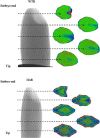X-ray computed tomography for quality inspection of agricultural products: A review
- PMID: 31660129
- PMCID: PMC6804772
- DOI: 10.1002/fsn3.1179
X-ray computed tomography for quality inspection of agricultural products: A review
Abstract
The quality of agricultural products relates to the internal structure, which has long been a matter of interest in agricultural scientists. However, inspection methods of the opaque nature of internal information on agricultural products are usually destructive and require sample separation or preparation. X-ray computed tomography (X-ray CT) technology is one of the important nondestructive testing (NDT) technologies without sample separation and preparation. In this study, X-ray CT technology is used to obtain two-dimensional slice images and three-dimensional tomographic images of samples. The purpose of the review was to provide an overview of the working principle of X-ray CT technology, image processing, and analysis. This review aims to focus on the development of the agricultural products (e.g., wheat, maize, rice, apple, beef) and its applications (e.g., internal quality evaluation, microstructure observation, mechanical property measurement, and others) using CT scanner. This paper covers the aspects regarding the advantages and disadvantages of NDT technology, especially the unique advantages and limitations of X-ray CT technology on the quality inspection of agricultural products. Future prospects of X-ray CT technology are also put forward to become indispensable to the quality evaluation and product development on agricultural products.
Keywords: agricultural products; computed tomography; nondestructive; quality inspection.
© 2019 The Authors. Food Science & Nutrition published by Wiley Periodicals, Inc.
Conflict of interest statement
The authors declare that they do not have any conflict of interest.
Figures






Similar articles
-
X-ray imaging methods for internal quality evaluation of agricultural produce.J Food Sci Technol. 2014 Jan;51(1):1-15. doi: 10.1007/s13197-011-0485-y. Epub 2011 Aug 13. J Food Sci Technol. 2014. PMID: 24426042 Free PMC article. Review.
-
Visualizing 3D Food Microstructure Using Tomographic Methods: Advantages and Disadvantages.Annu Rev Food Sci Technol. 2018 Mar 25;9:323-343. doi: 10.1146/annurev-food-030117-012639. Epub 2018 Jan 18. Annu Rev Food Sci Technol. 2018. PMID: 29350559 Review.
-
Visualizing morphological structures of rice grains in precooked products using synchrotron radiation X-ray phase-contrast computed tomography.Food Funct. 2023 Jan 3;14(1):87-93. doi: 10.1039/d2fo02714c. Food Funct. 2023. PMID: 36503985
-
High-dynamic-range micro-CT for nondestructive testing of titanium 3D-printed medical components.J Med Imaging (Bellingham). 2022 Jul;9(4):044004. doi: 10.1117/1.JMI.9.4.044004. Epub 2022 Aug 1. J Med Imaging (Bellingham). 2022. PMID: 35928636 Free PMC article.
-
Performance evaluation of an 85-cm-bore X-ray computed tomography scanner designed for radiation oncology and comparison with current diagnostic CT scanners.Int J Radiat Oncol Biol Phys. 2002 Mar 15;52(4):1123-31. doi: 10.1016/s0360-3016(01)02779-1. Int J Radiat Oncol Biol Phys. 2002. PMID: 11958910
Cited by
-
Assessment of Mechanical Damage and Germinability in Flaxseeds Using Hyperspectral Imaging.Foods. 2023 Dec 29;13(1):120. doi: 10.3390/foods13010120. Foods. 2023. PMID: 38201149 Free PMC article.
-
Unsupervised Foreign Object Detection Based on Dual-Energy Absorptiometry in the Food Industry.J Imaging. 2021 Jun 24;7(7):104. doi: 10.3390/jimaging7070104. J Imaging. 2021. PMID: 39080892 Free PMC article.
-
Investigating the Impact of the Degree of Sharpness on the Microstructure of Fresh-Cut Apples.Foods. 2025 Feb 14;14(4):636. doi: 10.3390/foods14040636. Foods. 2025. PMID: 40002080 Free PMC article.
-
An Improved Northern Goshawk Optimization Algorithm for Mural Image Segmentation.Biomimetics (Basel). 2025 Jun 5;10(6):373. doi: 10.3390/biomimetics10060373. Biomimetics (Basel). 2025. PMID: 40558342 Free PMC article.
-
Sub-Terahertz Imaging-Based Real-Time Non-Destructive Inspection System for Estimating Water Activity and Foreign Matter Depth in Seaweed.Sensors (Basel). 2024 Nov 28;24(23):7599. doi: 10.3390/s24237599. Sensors (Basel). 2024. PMID: 39686136 Free PMC article.
References
-
- Aguilera, J. M. (2005). Why food microstructure? Journal of Food Engineering, 67, 3–11. 10.1016/j.jfoodeng.2004.05.050 - DOI
-
- Anonymous . (2010, December 10). History of radiography. Retrieved from http://www.ndted.org/EducationResources/CommunityCollege/Radiography/Int...
-
- Arendse, E. , Fawole, O. A. , Magwaza, L. S. , & Opara, U. L. (2016). Non‐destructive characterization and volume estimation of pomegranate fruit external and internal morphological fractions using X‐ray computed tomography. Journal of Food Engineering, 186, 42–49. 10.1016/j.jfoodeng.2016.04.011 - DOI
-
- Baker, D. R. , Mancini, L. , Polacci, M. , Higgins, M. D. , Gualda, G. A. R. , Hill, R. J. , & Rivers, M. L. (2012). An introduction to the application of X‐ray microtomography to the three‐dimensional study of igneous rocks. Lithos, 148, 262–276. 10.1016/j.lithos.2012.06.008 - DOI
Publication types
LinkOut - more resources
Full Text Sources

